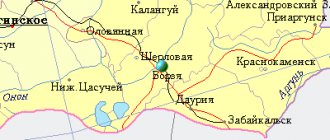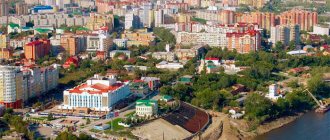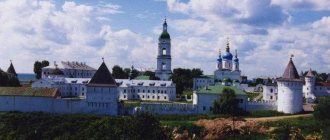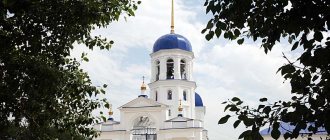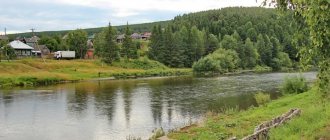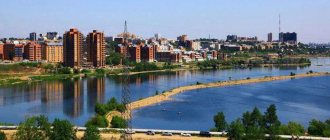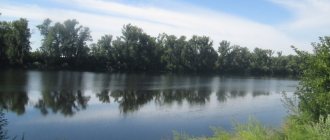| Lesozavodsk city
|
| A country | Russia, Russia |
| Subject of the federation | Primorsky KraiPrimorsky Krai |
| Urban district | Lesozavodsky |
| Coordinates | 45°28′00″ n. w. 133°24′00″ E. d. / 45.46667° n. w. 133.40000° E. d. / 45.46667; 133.40000 (G) [www.openstreetmap.org/?mlat=45.46667&mlon=133.40000&zoom=14 (O)] (Z)Coordinates: 45°28′00″ N. w. 133°24′00″ E. d. / 45.46667° n. w. 133.40000° E. d. / 45.46667; 133.40000 (G) [www.openstreetmap.org/?mlat=45.46667&mlon=133.40000&zoom=14 (O)] (I) |
| Based | in 1932 |
| City with | 1938 |
| Climate type | moderate monsoon |
| Population | ↘36,027[1] people (2016) |
| Names of residents | sawmill workers, sawmill worker, sawmill worker; lumbermen, lumberman |
| Timezone | UTC+10 |
| Postal codes | 692030—692042 |
| Vehicle code | 25, 125 |
| Official site | [lesozavodsk-pk.rf/ odsk-pk.rf] |
| Lesozavodsk Moscow |
| Vladivostok Lesozavodsk |
K: Settlements founded in 1932
Lesozavodsk
- a city in the Primorsky Krai of Russia. Located on the Ussuri River, 349 km from Vladivostok. It is part of the Lesozavodsky urban district. Population - 36,027[1] people. (2016). In the past, it was the center of the woodworking industry, hence the name of the city. Currently, there are no city-forming enterprises[2]. The largest employer is the junction railway station Ruzhino.
Story
The history of the city dates back to the formation in 1894 of villages on the banks of the Ussuri River by settlers from the Kyiv, Chernigov and Poltava provinces. At the turn of the 19th and 20th centuries, the first sawmill appeared on the left bank of the Ussuri next to the Trans-Siberian Railway. In 1924, a sawmill was founded on the right bank of the river, which later grew into the Ussuri Wood Processing Plant, the largest in the Far East of the country. The first settlement was called Dalles; in 1932 the village was united with the village of Novostroika, the villages of Donskoye (the former Cossack village of Donskaya), Lutkovka, Medveditskoye and the Ussuri railway station, receiving the modern name Lesozavodsk. In 1938, the workers' settlement received city status[3]. In 1972, a large plant for the production of feed yeast was established, in 1974 - the Ussuri clothing factory, in 1987 - a furniture factory[4].
Current data
The number of inhabitants is 2,196,000 inhabitants. In the cities of Primorye, the environment is not good. The plight is associated with companies that handle and transport coal in large quantities. A large anthropogenic load falls on the shoulders of residents. Transshipment of coal is carried out in an open way, but the situation is changing, the regulatory authorities have taken up the solution. Now government agencies are forcing companies to build protective devices and special structures to improve the disposal of industrial waste. The number of inhabitants in the territory in 2008 was 1,789,234.
The industrial industry of the Primorsky region does not lag behind in development. More than a hundred manufacturing plants operate at full capacity in the city.
- Askold - the plant produces high-quality pipeline fittings
- Spasskcement produces cement and clinker.
- The shipyard carries out repairs of ships of all models.
- has been operating since 2016, selling construction materials.
- Primorsky Plant is a large ship repair company. The company services 80-100 ships and boats annually.
- The Pacific Fleet Rope carries out repair work on ships of the naval forces of the FSB ocean fleet.
- PJSC is a company engaged in the production of steam power protection control systems.
Brown coal deposits have been found on the territory of Primorye. In 1932, mines were designed and a powerful hydroelectric power station was built.
Climate
| Climate of Lesozavodsk | |||||||||||||
| Index | Jan. | Feb. | March | Apr. | May | June | July | Aug. | Sep. | Oct. | Nov. | Dec. | Year |
| Average maximum, °C | −12,1 | −7,2 | 2,5 | 14,1 | 21,0 | 25,2 | 27,7 | 27,2 | 22,0 | 13,6 | 1,6 | −8,7 | 10,6 |
| Average temperature, °C | −18 | −13,5 | −4 | 7,0 | 14,1 | 19,3 | 22,6 | 21,8 | 15,3 | 6,7 | −4,4 | −14,5 | 4,4 |
| Average minimum, °C | −23,9 | −19,8 | −10,5 | −0,1 | 7,2 | 13,4 | 17,5 | 16,4 | 8,6 | −0,2 | −10,4 | −20,3 | −1,8 |
| Precipitation rate | 11 | 8 | 16 | 26 | 49 | 61 | 98 | 116 | 79 | 42 | 22 | 13 | 541 |
| Source: weather station "Lesozavodsk" | |||||||||||||
Statistics by year
Due to current trends, the statistics of people living in the territory of the Primorsky Territory is decreasing; in 2014, the number of people living in the region was 1941.6, in 2017 -1917.3, in 2022 it is predicted to be 1886.5. The picture presented is grim, with population decline occurring every year.
This phenomenon is associated with the remoteness of the object from the center, the high cost of moving, and the climatic features of the Primorsky Territory. Japanese citizens are gradually migrating to areas where they develop businesses and get jobs, but Russians still make up the bulk of the ethnic composition. The number of people in a city depends on the birth rate and population migration.
An excerpt characterizing Lesozavodsk
The horsemen who arrived were Napoleon, accompanied by two adjutants. Bonaparte, driving around the battlefield, gave the last orders to strengthen the batteries firing at the Augesta Dam and examined the dead and wounded remaining on the battlefield. - De beaux hommes! [Beauties!] - said Napoleon, looking at the killed Russian grenadier, who, with his face buried in the ground and the back of his head blackened, was lying on his stomach, throwing one already numb arm far away. – Les munitions des pieces de position sont epuisees, sire! [There are no more battery charges, Your Majesty!] - said at that time the adjutant, who arrived from the batteries that were firing at Augest. “Faites avancer celles de la reserve, [Have it brought from the reserves,” said Napoleon, and, having driven off a few steps, he stopped over Prince Andrei, who was lying on his back with the flagpole thrown next to him (the banner had already been taken by the French, like a trophy) . “Voila une belle mort, [This is a beautiful death,”] said Napoleon, looking at Bolkonsky. Prince Andrei realized that this was said about him, and that Napoleon was saying this. He heard the one who said these words called sire. But he heard these words as if he heard the buzzing of a fly. Not only was he not interested in them, but he did not even notice them, and immediately forgot them. His head was burning; he felt that he was emanating blood, and he saw above him the distant, high and eternal sky. He knew that it was Napoleon - his hero, but at that moment Napoleon seemed to him such a small, insignificant person in comparison with what was now happening between his soul and this high, endless sky with clouds running across it. He didn’t care at all at that moment, no matter who stood above him, no matter what they said about him; He was only glad that people were standing over him, and he only wished that these people would help him and return him to life, which seemed so beautiful to him, because he understood it so differently now. He mustered all his strength to move and make some sound. He weakly moved his leg and produced a pitying, weak, painful groan. - A! “He’s alive,” said Napoleon. – Raise this young man, ce jeune homme, and take him to the dressing station! Having said this, Napoleon rode further towards Marshal Lan, who, taking off his hat, smiling and congratulating him on his victory, drove up to the emperor. Prince Andrei did not remember anything further: he lost consciousness from the terrible pain that was caused to him by being placed on a stretcher, jolts while moving, and probing the wound at the dressing station. He woke up only at the end of the day, when he was united with other Russian wounded and captured officers and carried to the hospital. During this movement he felt somewhat fresher and could look around and even speak. The first words he heard when he woke up were the words of the French escort officer, who hurriedly said: “We must stop here: the emperor will pass by now; it will give him pleasure to see these captive gentlemen. “There are so many prisoners these days, almost the entire Russian army, that he probably got bored with it,” said another officer. - Well, however! This one, they say, is the commander of the entire guard of Emperor Alexander,” said the first, pointing to a wounded Russian officer in a white cavalry uniform. Bolkonsky recognized Prince Repnin, whom he had met in St. Petersburg society. Next to him stood another, 19-year-old boy, also a wounded cavalry officer. Bonaparte, galloping up, stopped his horse. -Who is the eldest? - he said when he saw the prisoners. They named the colonel, Prince Repnin. – Are you the commander of the cavalry regiment of Emperor Alexander? - asked Napoleon. “I commanded a squadron,” answered Repnin. “Your regiment honestly fulfilled its duty,” said Napoleon. “The praise of a great commander is the best reward for a soldier,” said Repnin. “I give it to you with pleasure,” said Napoleon. -Who is this young man next to you? Prince Repnin named Lieutenant Sukhtelen. Looking at him, Napoleon said, smiling: “II est venu bien jeune se frotter a nous.” [He came young to compete with us.] “Youth doesn’t stop you from being brave,” Sukhtelen said in a breaking voice. “Excellent answer,” said Napoleon. - Young man, you will go far! Prince Andrei, who, to complete the trophy of the captives, was also put forward, in full view of the emperor, could not help but attract his attention. Napoleon apparently remembered that he had seen him on the field and, addressing him, used the same name of the young man - jeune homme, under which Bolkonsky was reflected in his memory for the first time. – Et vous, jeune homme? Well, what about you, young man? - he turned to him, - how do you feel, mon brave? Despite the fact that five minutes before this, Prince Andrei could say a few words to the soldiers carrying him, he now, directly fixing his eyes on Napoleon, was silent... All the interests that occupied Napoleon seemed so insignificant to him at that moment, so petty seemed to him his hero himself, with this petty vanity and joy of victory, in comparison with that high, fair and kind sky that he saw and understood - that he could not answer him. And everything seemed so useless and insignificant in comparison with the strict and majestic structure of thought that was caused in him by the weakening of his strength from the bleeding, suffering and the imminent expectation of death. Looking into the eyes of Napoleon, Prince Andrei thought about the insignificance of greatness, about the insignificance of life, the meaning of which no one could understand, and about the even greater insignificance of death, the meaning of which no one living could understand and explain.
List of cities
Large agglomerates: Nakhodka and Vladivostok. The structure includes provincial points: Bolshoy Kamen, Artem, Dalnerechensk, Akhtarsk, Partizansk, Fokino, Spasik-Dalniy, Ussuriysk, Lesozavodsk, Dalnegorsk.
Arseniy forms the Arseninsky urban district. Founded in 1902 as the village of Semenovka, which united several points. The city has had an aviation service since war times. For 70 years it has been producing combat aircraft K52-navigator and K-50-black shark. Number of employees: 62,00 employees.
The population of Akhtarsk is 32,349 people. Elderly people live in a provincial facility, the required number of jobs is not provided, and there are no comfortable conditions. The infrastructure and economy of Akhtarsk are poorly developed; on the territory of the facility there is a kindergarten, a school, several shops, a clinic, a hospital. Akhtarsk, remote from the center, is experiencing budgetary difficulties that are difficult for the local administration to solve without the help of the ministry.
Dalnorechensk population 28,482 people. The point was developed by the Cossacks and named the village of Grafskaya, in honor of N. N. Muravyov. Since 1897 it was called Iman in Chinese, but after 1972 as a result of the Chinese conflict, it was renamed Dalnorechensky. The province is located on the banks of the Malinovka and Ussuri rivers. 3 km before Dalnorechensk there are three extinct volcanoes of the Salskaya Sopka. To get to the center of the capital you need to travel 400 km. Logistics. Transport services are minibuses, buses and taxis. On clear days, from almost anywhere in the city you can see the outlines of mountain ranges - the spurs of the Sikhote-Alin. Yes, and don’t forget about the taiga: the diversity of flora and fauna, rivers and lakes.
In total there are 12 cities and 26 rural areas. Artem has a population of 106,440 citizens and is located along the Knevichanka River. The name of the reservoir is of semi-Japanese origin. In the 1920s, before the Japanese War, people with Japanese cultural heritage lived on the territory of the city of Artem.
Natural increase
Natural increase allows you to find out the percentage of increase in the birth rate that prevails over the number of deaths. In 2018, the natural increase is 5665, in 2022 -7529, which indicates an increase in the decline in the share of citizens. For example, in 2022 the number of deaths exceeded the number of births by 7498, that is, the number of citizens of the region decreased by 6.8 thousand inhabitants. In 2022, the number of deaths became equal to 2701.
The increase in migration did not affect the restoration of the demographic situation in the region, since only 600 people arrived in Primorye. Referring to current information from 1.01. In 2020, 1,895,900 people lived in the territory of the Primorsky Territory. In 2019, there were 1,902,700 residents, 18.2 thousand were born, and 25,000 died. From 2022 to 22020, the region lost more than 13,000 people of the stronger sex.
Age and sex composition
The population of the Primorsky Territory is 1,895,868 people, of which 174,060 are men, 165,050 are women, and 339,110 are children. Information collected from official information as of January 1, 2020. Women of working age (over 55) are equal to - 1099785. A separate category, city statistics - men - 131872, women - 124677, children - 256549. Rural density of the Primorsky Territory: men - 42188, women - 40373.
Migration
Migration movement for 2022. In 2022, 34,000 residents arrived in the Primorsky Territory, almost 60% were Russians who arrived from abroad - 13,900. -33,400 left the Primorsky Territory, the flow coefficient is 0.7. 2022 was productive. The level of the number of visitors has exceeded the 2022 attendance threshold. From 2015 to 2018, the number of residents decreased by 15,000. Primorsky Krai always remains in first place in seafood production.
Forecast. According to young people and economic experts, the region is located far from the center and has no prospects for business development. Migration outflow occurs either gradually or abruptly. The influx of migrants comes from the shores of the Japanese islands. Residents from neighboring countries (Japan) are actively involved in fishing, trade, and scientific and technological research in the Primorsky Territory. The indigenous inhabitants of Primorye immigrate to remote regions of Russia; the climatic conditions and microclimate are not suitable for most residents.
